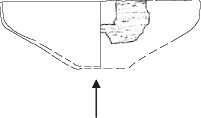Chronology is an important aspect of archaeology, and several different methods are available to determine the age of various archaeological materials. When it is not possible to associate material with a date, however, it is useful to at least determine the

Domestic cooking vessel



Figure 5 An example showing two hypothesized vessel function lines through three ceramic styles in a local area with cultural continuity. Adapted from the author's work, US Virgin Islands.
Sequential position of materials, in relation to other (earlier and later) materials. This is called ‘relative dating’. Pottery often has proved to be useful evidence for relative dating because of its many variables subject to change through time.
One of the specific methods developed to derive relative dating from artifacts is seriation, a process for placing samples in serial order. The seriation method compares the quantities of selected artifactu-al types in different samples. It is based on the theoretical waxing and waning of the popularity of any given artifact trait. As an example, there might be a situation in which there are several collections of pottery sherds from the surfaces of sites in a given locality but neither their dating nor their sequential order is known. In that case seriation might prove useful in placing the sites in sequential order (based on their surface assemblages). First, the analyst defines a limited number of ceramic traits that appear To be differentially represented in the assemblages. Then, all sherds are examined and the occurrences of those traits are counted and converted to percentages for each assemblage. Finally, the percentage frequencies are compared, often by means of a graphic device like a bar chart. The objective is to order the samples such that the frequency of each of the selected traits consistently increases and/or decreases.
Figure 6 Shows how a seriation chart is composed, in simplified form. The samples shown must be placed in sequence either as A-B-C-D or as its reverse, D-C-B-A. Any other sequence would destroy the regular progression of frequency for trait types 1 and 2. It is not possible to know which end of the sequence is first and which is last, however, unless there is additional information from other sources.
This method provides only rough estimates of relative chronology. Many social or historical factors potentially might affect the popularity curve for any given ceramic trait, in such a way that it would not conform to the hypothetical model. An estimate, however, can be very useful as a basis of hypotheses for later testing.
More complex methods of seriation, derived from the same principles, have been developed to fit individual circumstances for purposes other than relative dating. For example, some scholars have found it possible to estimate a calendrical date range for an archaeological deposit if it includes various artifacts of known periods of popularity. Figures representing the relative abundance of such artifacts are inserted in mathematical formulae to obtain the date estimate.




 World History
World History









